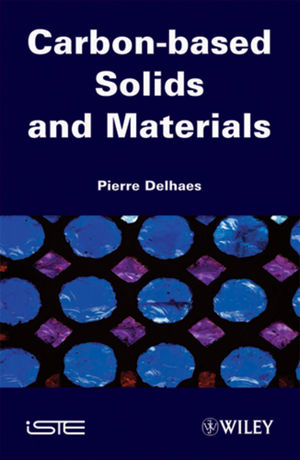
Carbon-based Solids and Materials
ISTE Ltd and John Wiley & Sons Inc (Verlag)
978-1-84821-200-8 (ISBN)
The cause of this rich polymorphism is analyzed in the first part of this book (chapters 1-5) with the propensity of carbon atoms for forming different types of homopolar chemical bonds associated with variable coordination numbers. Precursor organic molecules and parent compounds are also described to establish specific links with this rich polymorphism.
Then in a second part (chapters 6-10) a comparative review of the main classes of bulk physical properties is presented. This approach emphasizes in particular the electronic behavior of (pi) polyaromatic systems organized in plane and curved atomic sheets. Finally in a third part (chapters 11-15) the surface and interface characteristics are introduced together with the texture and morphology of these multiscale carbon materials. An overview of the main field of applications is related showing the large use and interest for these solids.
Pierre Delhaes, Emeritus Research Director, Research Center Paul Pascal, CNRS and University of Bordeaux.
Introduction xiii
PART 1. CARBON PHASES, PRECURSORS AND PARENT COMPOUNDS 1
Chapter 1. A Historical Overview 3
1.1. The alchemy of carbon 3
1.2. Elemental carbon and its allotropic varieties 5
1.3. Novel molecular varieties 7
1.4. Natural forms 9
1.5. Contribution from quantum mechanics 14
1.6. Conclusion 21
1.7. Bibliography 21
Chapter 2. Polymorphism of Crystalline Phases 25
2.1. Thermodynamic stability and phase diagram 25
2.2. Classical forms of carbon 37
2.3. Molecular and exotic forms 43
2.4. State of the art and conclusion 53
2.5. Bibliography 54
Chapter 3. Non-Crystalline Carbons 61
3.1. Reminder about defects and imperfections in networks 62
3.2. Thermodynamic approach and the classification of solids 70
3.3. Fabrication and characterization techniques 81
3.4. Conclusion 92
3.5. Bibliography 93
Chapter 4. Derivative Compounds and Analogs 97
4.1. Doping carbons and solid solutions 98
4.2. 2D and 3D analog compounds 111
4.3. Similar materials 116
4.4. Conclusion 118
4.5. Bibliography 118
Chapter 5. From Aromatic Precursors to the Graphene Plane 127
5.1. Condensed polyaromatic systems 128
5.2. The graphene plane 151
5.3. Current situation and conclusion 160
5.4. Bibliography 160
PART 2. PHYSICAL PROPERTIES OF SOLID CARBONS 169
Chapter 6. General Structural Properties 171
6.1. Elastic and mechanic properties 172
6.2. Thermal properties 188
6.3. Conclusion 207
6.4. Bibliography 208
Chapter 7. Electronic Structures and Magnetic Properties 217
7.1. Electronic band structures 218
7.2. Static magnetic properties 227
7.3. Electron spin (or paramagnetic) resonance 240
7.4. NMR 252
7.5. Conclusion 255
7.6. Bibliography 256
Chapter 8. Electronic Transport Properties 265
8.1. Electrical conductivity 270
8.2. Galvanomagnetic properties 293
8.3. Thermoelectric properties 305
8.4. Conclusion 310
8.5. Bibliography 310
Chapter 9. Optical Properties and their Applications 321
9.1. Properties in linear optics 325
9.2. Nonlinear and photo-induced properties 344
9.3. Analysis methods and applications 351
9.4. Conclusion 358
9.5. Bibliography 358
Chapter 10. Vibrational Properties 369
10.1. Phonon spectra in crystalline phases 370
10.2. Specific characteristics of Raman scattering 383
10.3. Data from infrared spectroscopy 394
10.4. Conclusion 399
10.5. Bibliography 400
PART 3. CARBON MATERIALS AND USES 409
Chapter 11. Surface and Interface Phenomena 411
11.1. Physical-chemistry characteristics 412
11.2. Electric and electrochemical aspects 429
11.3. Solid interfaces, tribology and mechano-chemical effects 439
11.4. Conclusion 449
11.5. Bibliography 450
Chapter 12. Chemical Reactivity and Surface Treatment 461
12.1. Oxidation reactions 463
12.2. Hydrogenation and halogenation reactions 480
12.3. Surface treatment and heterogenous catalysis 486
12.4. Conclusion 492
12.5. Bibliography 492
Chapter 13. Divided and Porous Carbons 503
13.1. General presentation of heterogenous carbons 504
13.2. Properties of porous carbons 516
13.3. Competition between chemical reactions and diffusion 533
13.4. Conclusion 540
13.5. Bibliography 541
Chapter 14. Carbon Filaments, Composites and Heterogenous Media 553
14.1. Carbon filaments 554
14.2. Role in composite materials 563
14.3. Random heterogenous media 572
14.4. Conclusion 581
14.5. Bibliography 581
Chapter 15. Use of Carbon Materials 591
15.1. Sensing applications and nanoelectronics 592
15.2. Carbon for energy 596
15.3. Thermostructural composites and transport 610
15.4 Carbons for chemistry and environmental problems 615
15.5. Biocarbons 618
15.6. General conclusion 621
15.7. Bibliography 621
Main Signs and Symbols 631
List of Basic Boxes 634
Index 635
| Erscheint lt. Verlag | 14.12.2010 |
|---|---|
| Verlagsort | London |
| Sprache | englisch |
| Maße | 158 x 236 mm |
| Gewicht | 1066 g |
| Themenwelt | Technik ► Maschinenbau |
| ISBN-10 | 1-84821-200-3 / 1848212003 |
| ISBN-13 | 978-1-84821-200-8 / 9781848212008 |
| Zustand | Neuware |
| Haben Sie eine Frage zum Produkt? |
aus dem Bereich


